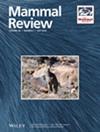Exploring the Drivers of Ocelot Population Density: A Systematic Review and Meta-Analysis of Methodological and Ecological Influences
Abstract
Background
Camera trapping associated with capture–recapture models is commonly used to estimate wild felid population density, relying on three main frameworks: spatially explicit capture–recapture (SECR) and two non-spatial approaches (CR-MMDM and CR-hMMDM). Methodological differences, inappropriate sampling designs, and/or insufficient data explain some estimate variability, but the biological factors underpinning this remain undetermined. Prey availability, habitat suitability, and body size may all interact and influence carnivoran population size and density.
Aims
We aimed to (1) survey ocelot population density data and summarise information on study designs, methodological approaches, and results, (2) evaluate the relationships between them, (3) disentangle methodological and ecological effects on population density estimates, and (4) provide guidance to improve study design and reporting.
Materials & Methods
Our systematic review discovered 51 studies reporting 228 ocelot population density estimates from 65 sites across 13 countries. We collated ocelot body mass data (BM) and used forest canopy height (GFCH) as a surrogate for habitat suitability, as well as gross primary productivity seasonality (GPP variation) as a proxy for prey availability. Using a meta-analytical framework, we created models to (1) determine mean ocelot population density in the Neotropics and to assess the effects of (2) methodological and (3) ecological variables on population density estimates.
Results
Mean population density was 20.3/100 km2, with significant differences among methods. SECR and CR-MMDM yielded comparable estimates (16.6/100 km2 and 18.9/100 km2, respectively), while CR-hMMDM produced higher estimates (27.3/100 km2). We found significant positive and negative effects of GFCH and BM, respectively, and a marginally significant negative effect of GPP variation on estimates.
Discussion
Ocelots thrive in forests with higher canopies, but their population density is limited by local habitat seasonality. Morphological differences further influence variation, with small-bodied populations attaining higher population densities under similar ecological conditions.
Conclusion
Based on our findings, we provide guidelines to enhance the accuracy and standardization of study designs, methodological approaches, and general reporting. Improving these aspects will strengthen the comparability and reliability of ocelot population density estimates.



 求助内容:
求助内容: 应助结果提醒方式:
应助结果提醒方式:


